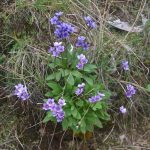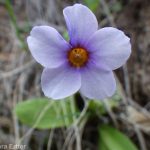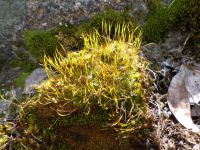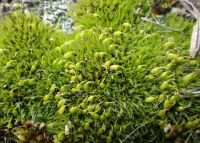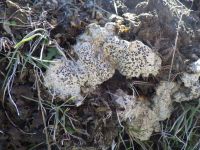(in collaboration with Carol Prentice)
Our sole native true primrose is officially known as Cusick’s primrose (Primula cusickiana), but locally it is sometimes referred to as Wilcox’s primrose, or even wilcoxiana. The reason why is intertwined with the early history of Boise.
The story begins with Captain Timothy Erastus Wilcox (1840-1932), who was posted as Assistant Surgeon at Fort Boise from June 1879 to August 1882. With the Fort conveniently situated at the base of the Boise Foothills, near the mouth of Cottonwood Creek, Wilcox was able to indulge his naturalistic bent, and may in fact be the first Boise resident to have made plant collections that ended up in permanent herbaria. Among his claims to fame is a paper that he published in Nature calling attention to the absence of earthworms in Boise; evidently they did not occur here until introduced by settlers. He is also credited with introducing pheasant and bobwhite in Oregon and Idaho (Ewan & Ewan 1981). As part of his official duties, Wilcox was even delegated with providing daily weather observations, a task required by U.S. Army Post Surgeons during Wilcox’s tenure at Fort Boise (Smith 2017).*
The plants Wilcox collected in Boise were sent to botanists in New York, where they triggered this write-up in the July 1881 issue of Bulletin of the Torrey Botanical Club:
“Idaho Plants.—The acknowledgements of the Torry Club are due to Dr. T. E. Wilcox, U.S.A., of Boisee[sic] City, Idaho, for several packages of plants of that vicinity collected in April and May of this year. Many interesting species are represented; among them, Delphinium decorum var. Nevadense, Watson; Brodiaea laxa, Watson; Fritillaria pudica, Spreng.; Allium nevadense, Watson; Balsamorrhiza[sic] Hookeri, Nutt.; Antennaria dimorpha, T. & G.; Crepis occidentalis, Nutt.; Lupinus Chamissonis, Eschs.; Mertensia oblongifolia, DC.; Plectritis congesta, DC.; also a dwarf primrose of the same general size and habit as Primula angustifolia, but having a from 1–5-flowered scape and showing also marked differences in the inflorescence from that described by Dr. Gray. Prof. Wood regarded this as a variety of P. Parryi, Gray, and named it var. Wilcoxiana. It appears to be the same as var. Cusickiana, Gray, of P. angustifolia (N. A. Flora, p. 393) except that the last-named variety is described as only 2-flowered. P. angustifolia flourishes in its typical, 1-flowered form, on high mountain elevations, such as Gray’s and Pike’s Peak, at 11,000 ft. to 13,000 ft., where we have found it abundant. The many-flowered forms grow at much lower elevations (where P. parryi, a much larger species, is found) but the foliage shows no marks of any greater vigor in the plants. It is possibly a distinct species.”
The “Prof. Wood” who proposed naming the Primula in honor of Wilcox is Alphonso Wood (1810-1881), the principal of Brooklyn Female Academy and the first to use dichotomous keys in his “Class-Book of Botany”; most of Wood’s own herbarium is now at New York Botanical Garden. However, neither Wood nor any other botanist ever actually followed through on formally describing Wilcox’s collection of Primula as either a distinct variety or a species, though the exact relationship between plants in the Boise Front (“wilcoxiana”) and plants in the Wallowa Mountains of northeastern Oregon has been an ongoing question. The latter location is where William C. Cusick made the collection that Asa Gray described first as Primula angustifolia var. cusickiana, and then elevated to a full species.
The use of “Wilcoxiana” as a local common is confirmed in Bernice Bjornson’s 1946 Key to the Spring Flora of Southwestern Idaho, a mimeographed collector’s item that I myself used in a biology class in Boise High School. In it, Bjornson notes that:
“A few places in the West are fortunate in having the attractive little primrose known in southern Idaho as Wilcoxiana, Primula cusickiana. Its leaves are simple, entire, and basal. Its flowers borne on a leafless stalk vary in color from pale blue to dark purple with a yellow eye. They are fragrant. People who lived in southwestern Idaho in the early 1900’s tell us that in spring the foothills used to be a mass of color with these flowers. Surely this is a flower which needs protection; one has to hunt for it nowadays.”
Although the primrose was never formally published, at least one plant was officially named in Wilcox’s honor: Quercus wilcoxii Rydb., from Arizona (now included within Quercus chrysolepis s.l., canyon live oak). The cactus genus Wilcoxia Britton & Rose (now a section of Echinocereus) is also named after him, from the period he was posted in Arizona. However, the majority of plants with the epithet wilcoxii or wilcoxiana are named after other plant-collecting Wilcoxes. As a prime example, Wilcox’s penstemon (Penstemon wilcoxii), whose lovely blue flowers grace higher elevations in the Boise Front, is named in honor of Earley Vernon Wilcox, a biology professor at University of Montana 1896-1899 (Ewan & Ewan 1981).
More information on Wilcox’s life can be found in his obituary (Eggleston, 1933). He was born in North Litchfield, New York, on 26 April 1840, and received his M.D. from Albany Medical College in 1864. Noteworthy events in his career included attending Jefferson Davis during his detention at Fortress Monroe after the Civil War. He went to Cuba in 1898 (i.e., during the Spanish-American War) as lieutenant-colonel chief surgeon and was honorably discharged the following year. He joined the Torrey Botanical Club in 1880, after being proposed for membership by Alphonso Wood, and was made a life member in 1930. From 1917 onward he was nearly blind, but his mind was clear until his death in 1932. Wilcox is buried in Arlington Cemetery, along with his wife Clara Brainard Brown.

Extended version published in Sage Notes:
Ertter, B. & C. Prentice. Dr. Wilcox—Army Doctor, Botanist—and his primrose: Part 1. Sage Notes 44(2): 1, 4–5, 9.
Prentice, C. & B. Ertter. 2023. Dr. Wilcox—Army Doctor, Botanist—and his primrose: Part II. Sage Notes 44(3): 1, 4–6, 13. (C. Prentice & B. Ertter).
Prentice, C. & B. Ertter. 2022. Dr. Wilcox—Army Doctor, Botanist—and his primrose: Part III. Sage Notes 44(4): 1, 4–7.
Recording of talk to Pahove Chapter, Idaho Native Plant Society, on 7 Oct 2023: “Timothy E. Wilcox: Army Surgeon at Fort Boise, Boise’s first resident Botanist/Naturalist” https://youtu.be/ZyEnwPc5rtQ
_____________________________________________
*Reports of local weather at stations throughout the country were telegraphed to a central location in Washington, D.C., where they were compiled and analyzed as the foundation to understanding broad-scale climatic patterns. As of 1877, the inclusion of weather reporting in the duties of medical personnel at Fort Boise overlapped those of U.S. Signal Service Observers. The first of these, Sergeant Barnet Edward Light, was my great-grandfather, and the beginning of my own roots in the Boise Front.
_____________________________________________
References:
Brown, A. 1881. Idaho Plants. Bulletin of the Torrey Botanical Club 8(7): 81-83.
Bjornson, Bernice. 1946. A Key to the Spring Flora of Southwestern Idaho. mimeographed, 121 pp. Copyright by the author.
Eggleston, W. W. 1933. Obituary: Timothy E. Wilcox. Science 77 (1995): 300.
Ewan, J., and N. D. Ewan. 1981. Biographical Dictionary of Rocky Mountain Naturalists. Regnum Vegetabile vol. 107. citing Auk 2 (1885): 315.
Smith, J. D. 2017. The History of Weather Observation — Boise Idaho. NOAA Technical Memorandum NWS WR-291. https://www.weather.gov/media/wrh/online_publications/TMs/TM-291.pdf
